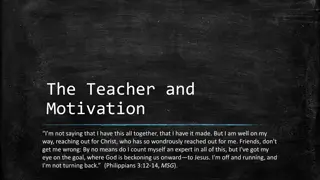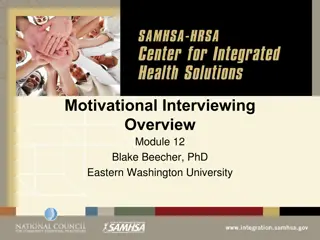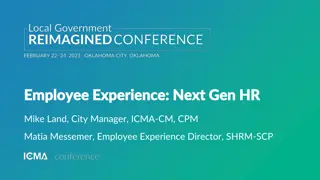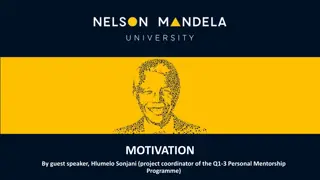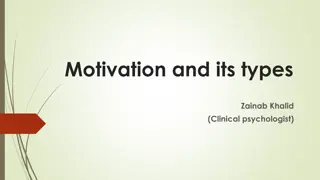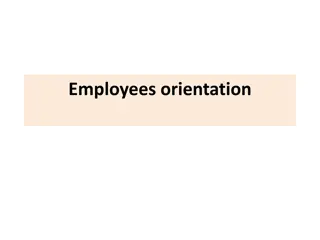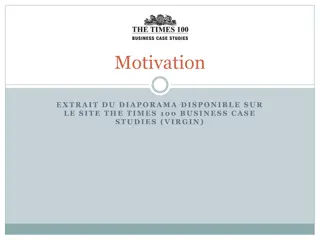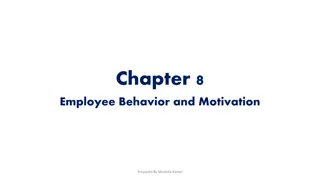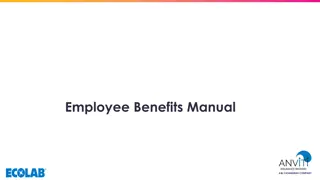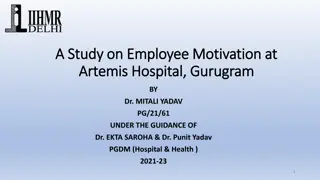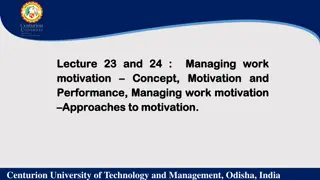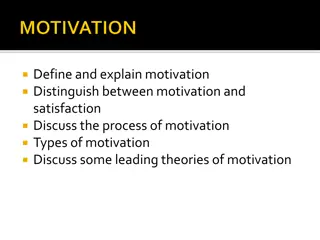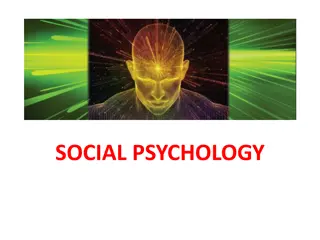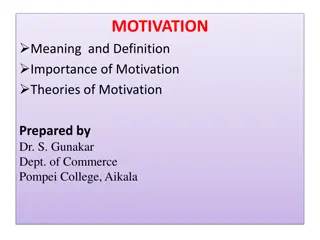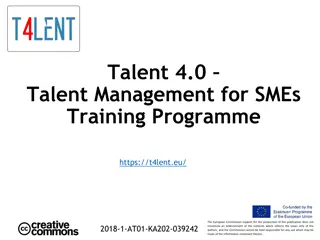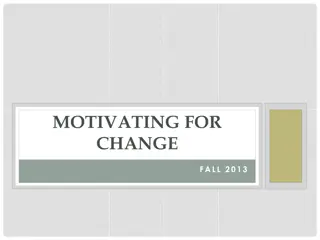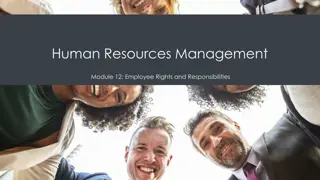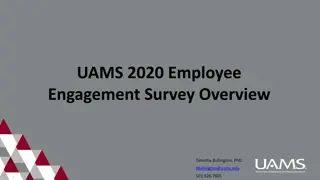Understanding Employee Motivation and Engagement
Exploring the process of employee motivation, this content delves into goal-directed behavior, needs, satisfaction, and theories like Vroom's Expectancy Theory and Ulrich's Stages of Employee Connection. Ultimately aiming for commitment, this analysis provides valuable insights into enhancing employee engagement.
Download Presentation

Please find below an Image/Link to download the presentation.
The content on the website is provided AS IS for your information and personal use only. It may not be sold, licensed, or shared on other websites without obtaining consent from the author. Download presentation by click this link. If you encounter any issues during the download, it is possible that the publisher has removed the file from their server.
E N D
Presentation Transcript
EMPLOYEE MOTIVATION PROCESS Goal Directed Behavior Need Need Motivation Satisfaction
EXPECTANCY THEORY (VROOMS) Yes Yes Motivated No No Not Motivated Not Motivated
ULRICHS STAGES OF EMPLOYEE CONNECTION x x = Commitment Connection Productivity Competence
TUCKMAN TEAM DEVELOPMENT MODEL Teams go through four stages. Teams can regress when membership changes. A mature team may need no leadership Performing Leader delegates and overseas Norming Leader facilities Effectiveness Storming Leaders mediates and focuses The leaders goal is to make the team self reliant and then move on. Forming Team is dependent on the leader Time
THE FOUR CONTRIBUTION STAGES Explain how careers develop in distinct stages each different from another. STAGE 1 STAGE 2 STAGE 3 STAGE 4 Dependently Independently Through Others Strategically Willingly accepts supervision Assumes significant responsibility Develops broader business perspective, help others understand in the broader business context and needs. Provides strategic direction Demonstrates competence on a portion of a larger project Builds organizational capability through work system and process improvement. Relies on less supervision, works independently and produces results Contributes to the performance of others as a manager, mentor, or idea leader. Performs effectively on detailed and routine tasks Builds expertise Exercise power for the benefit of the organization. Shows directed creativity and initiative Develops credibility and a reputation Sponsors and prepares future leaders. Represents the work group on important issues. Performs well under time and budget pressure Builds a strong collegial network Represents the organization to key external groups on critical strategic issues. Builds a strong internal and external network. Learns how we do things
COMPENSATION TYPES Direct Financial Compensation Indirect Financial Compensation (Benefits) Non-Financial Compensation dfgsdfgdsfg
FORMS OF INCENTIVE COMPENSATION Profit Sharing Gain Sharing Pay for Knowledge Lump-Sum Bonus Bonus based on company profits. Bonus based on productivity gains, cost savings, or quality improvements. Salary increase based on learning new job tasks One time cash-payments or option to buy shares of company stock based on performance.
MASLOWS HIERARCHY OF NEEDS THEORY People have five levels of needs that seek to satisfy Self- Actualization Morality, idealism, creativity, spontaneity, problem solving. Esteem Self-esteem, confidence and achievement, respect of others. Love / Belonging Friendship, partnership, family, sexual intimacy. Security of: body, employment, resources, morality, family, health, property. Safety Breathing, food, water, sex, sleep, homeostasis, excretion. Physiological
HUMAN RESOURCE RESPONSIBILITIES Planning for staffing needs Employee recruitment and selection Core Responsibilities of HRM Employee compensation and benefits Employee training and performance evaluation Employee compensation and benefits
HRM DEVELOPMENTAL STAGES FOR SMALL GROUPS Tuckman s model Forming Storming Norming Performing Team members meet each other Team members learn how to work together Team starts to work and act together Team members work hard toward goal Team members learn about the task Team members learn about the other members Roles evolve into helping the team succeed Members are flexible and help each other All team members learn what their roles will be Team members are more likely to express opinions Leader s role is blurred everyone is focused Leader focuses the team
Strategic Positioner Capability Builder ULRICH S HR COMPETENCY MODEL HR Innovator & Integrator Champion Credible Activist Change HR Innovator & Integrator
THE LEADERSHIP CODE 5 RULES FOR LEADERSHIP Long-Term Strategic Human Capital Developer Strategist Build the next generation Shape the future Personal Proficiency Individual Organization Talent Manager Executor Engage today s talent Make things happen Operational Near-Term
OPERATIVE FUNCTIONS OF HRM Maintenance /Motivation Procurement Development Compensation Integration Job analysis and design Career planning and development Job evaluation Employee well-being Industrial relations Performance evaluation Social security Discipline Human resource planning Worker s training Worker s participation Grievance redressed Executive development Wages administration Dispute settlement Recruitment Motivation Collective bargaining Selection Organizational development Incentives and benefits Job rotation Placement HR Records, research and audit Orientation Socialization HR information system
FOUR STAGES OF CONTRIBUTION MODEL Impact Contribute Dependently Contribute Independently Contribute Through Others Contribute Strategically Key Transitions (Novation s)
PEOPLE CAPABILITY MATURITY MODEL Level 5 Continuously improving practices Optimizing Level 4 Measured and Capability aligned practices Management Managed Level 3 Tailored Team practices Management Defined Level 2 Managed Competence practices Management Repeatable Level 1 People Management Initial
HERZBERGS THEORY OF MOTIVATION Hygiene Factors Motivational Factors Interpersonal relationships, supervisors, peers and subordinates Work itself Achievement Technical supervision Possibility of growth Company policy administration Responsibility Job security Advancement / Recognition Working conditions Status Salary / personal life
GUEST MODEL OF HRM Organizational Outcomes Human Resource Outcomes High job performance High problem-solving Successful change Strategic planning/ implementation Policies Low turnover Low absence Commitment Low grievance level Organizational job design Flexibility/ adaptability High cost-effectiveness Policy formulation and implementation/management of change Quality Recruitment, selection and socialization Appraisal, training and development Manpower flows, through, up and out of the organization Rewards systems Communications system
Relationship Management Communication Ethical Practice Consultation HR COMPETENCY MODEL SHRM Leadership and Navigation HR Expertise Diversity and Inclusion Business Critical Evaluation
HR ANALYTICS MATURITY MODEL Stage 4: Predictive Analysis Development of predictive models, scenario planning, risk analysis and mitigation, integration with strategic planning Stage 3: Strategic Analysis Segmentation, statistical analysis, development of people models, analysis of dimensions to understand cause and delivery of actionable solutions. Stage 2: Advanced Reporting Operational reporting for benchmarking and decision making, multi-dimensional analysis and dashboards. Stage 1: Operational Reporting Operational reporting for measurement of efficiency and compliancy, data exploration and integration, development of data dictionary
HIGH IMPACT LEARNING ORGANIZATION MATURITY MODEL Level 4: Organizational Capability Source of: Business performance capability & learning agility, executive drive, cultural & systematic focus Level 3: Talent & performance improvement Source of: talent development and performance consulting, integrated with HR/TM improving alignment, process & tech focus. Level 2: Training and developing excellence Source of: designed instruction, evolving governance & operations, improving L&D core processes, program focused. Level 1: Incidental Training Source of: ad-hoc job support, mentoring and apprenticeship, emerging need for professional training, SME focused.
Inception Strategic human Resource planning Recruiting Employee presentation Maintenance Development HRM GOALS HRM Goals Benefit administration Safety and health Communication programs Employee training Employee development Motivation TQM and productivity Rewards Compensation
MODEL OF STRATEGIC HRM Corporate Objective HR Objective Individual Objectives Developing and Retaining Planning Staffing Assessing Recognizing Letting Go
Achieving results Effective relationships Personal Communication Strategic Contribution NEW HR COMPETENCY MODEL Culture Management Fast Change Strategic Decision-Making Market-driven Connectivity Staffing Development Organizational structure Performance Management
THE WARWICK MODEL OF HRM Outer Context Socioeconomic, Technological, Political-legal, Competitive Inner Context Culture, structure, politics/leadership, task technology, business outputs Business Strategy Content HRM Context Objectives, product market, strategy and tactics Role, definition, organization, HR outputs HRM Content HR flows, work systems, reward systems, employee relations
HRM FUNCTIONS HRM Compensation
Team Learning 5 COMPONENTS OF A LEARNING ORGANIZATION Building Shared Vision Systems Thinking Focusing on group solving using systems thinking Personal Mastery Mental Models
INTEGRATING HRM WITH BUSINESS OUTCOMES Continuous Learning Human Resourcing Shaping The Working Environment Performance Accountability Shared Understanding
Environmental Strategic human Resource planning Recruiting Legal Employee & Labor Relations Framework & Practice Strategic human Resource planning Recruiting Strategic human Resource planning Recruiting HR MANAGEMENT ACTIVITIES Technological Political Risk management and worker protection Staffing Strategic human Resource planning Recruiting Strategic human Resource planning Recruiting Talent Total Rewards Management Strategic human Resource planning Recruiting Strategic human Resource planning Recruiting Legal
HR COMPETENCY MODEL International Personnel Management Association (IPMA) Model Leader Business Partner Change Agent HR Expert
HUMAN RESOURCE DEVELOPMENT Designed to provide learners with knowledge and skills Training Designed to provide learners with knowledge and skills Designed to provide learners with knowledge and skills Performance Appraisal Development Performance Management Career Planning Designed to provide learners with knowledge and skills Designed to provide learners with knowledge and skills Organization Development Career Development Designed to provide learners with knowledge and skills Designed to provide learners with knowledge and skills
THE HARVARD MODEL OF HRM Stakeholder Interests Stakeholders Management Employee groups Government Long-Term Consequences HRM Policy Choices HR Outcomes Community / Unions Stakeholders Stakeholders Management Management Stakeholders Employee groups Employee groups Management Government Government Employee groups Situational Factors Stakeholders Management Employee groups Government Community / Unions
FOUR STAGES OF CONTRIBUTION MODEL STAGE 1 STAGE 2 STAGE 3 STAGE 4 Dependently Independently Through Others Strategically Designed to provide learners with knowledge and skills Designed to provide learners with knowledge and skills Designed to provide learners with knowledge and skills Designed to provide learners with knowledge and skills Performance Expectation Designed to provide learners with knowledge and skills Designed to provide learners with knowledge and skills Designed to provide learners with knowledge and skills Designed to provide learners with knowledge and skills Primary Role Designed to provide learners with knowledge and skills Designed to provide learners with knowledge and skills Designed to provide learners with knowledge and skills Designed to provide learners with knowledge and skills Major Stage Transition Issue Designed to provide learners with knowledge and skills Designed to provide learners with knowledge and skills Designed to provide learners with knowledge and skills Designed to provide learners with knowledge and skills Minor Stage Transition Issue
Change Management Performance Improvement Knowledge Management Instructional Design Competencies for the Training & Development Profession ASTD COMPETENCY MODEL (2013) Training Delivery Coaching Integrated Talent Management Learning Technologies Managing Learning Programs Evaluate Learning Impact Areas of Expertise Business Skills Global Mindset Industry Knowledge Foundation Competencies Interpersonal Skills Personal Skills Technology Liberace
THE EMOTIONAL COMPETENCY FRAMEWORK Self Others Awareness An HR department is an essential, if not critical, component of any business regardless of the organization's size. An HR department is an essential, if not critical, component of any business regardless of the organization's size. Self Social Awareness Awareness An HR department is an essential, if not critical, component of any business regardless of the organization's size. An HR department is an essential, if not critical, component of any business regardless of the organization's size. Actions Self Social Skills Management Positive impact on others
ULRICHS MATRIX ON THE 4 ROLES OF HR Future / Strategic Focus Strategic Partner An HR department is an essential, if not critical, component of any business regardless of the organization's size. Change Agent An HR department is an essential, if not critical, component of any business regardless of the organization's size. Process People HR Administrative Expert An HR department is an essential, if not critical, component of any business regardless of the organization's size. Employee Champion An HR department is an essential, if not critical, component of any business regardless of the organization's size. Day to day / Operational Focus
Primary HRD Functions Improving individual, group, and organizational effectiveness. Training & Development HR Research & Info Systems Organization Development Union / Labor Relations Career Development MCLAGAN S HUMAN RESOURCE WHEEL Human Resource Result An HR department is an essential, if not critical, component of any business regardless of the organization's size. Employee Assistance Organizational/ Job Design Compensation & Benefits Human Resource Planning Performance Management System Selection & Staffing Primary HRM Functions Obtaining, Maintaining and developing employees.
Service delivery and information Organization design THE HR PROFESSION MAP BY CIPD Employee relations Organization development Leading and managing the human resource function Strategy insights and solutions Employee engagement Resourcing and talent planning Learning and talent development Performance and reward
BRIDGES TRANSITION MODEL The New Beginning Importance Ending, Losing, Letting Go Time
ULRICHS MATRIX ON THE 4 ROLES OF HR Future / Strategic Focus Strategic Partner Change Agent Management of strategic human resources Management of transformation and change Process Oriented People Oriented HR Management of employee contribution Management of firm infrastructure Administrative Expert Employee Champion Day to day / Operational Focus
HR STRATEGY MAP Financial Enhance ROI of HR Strategic Initiatives Enhance employee productivity Internal Customers Create positive work environment Enhance Internal Customer satisfaction Apply excellent recruitment process Develop strategic employee competencies Implement best talent management practices Optimize performance management system HR Internal Process Learning Develop Internal HR Capabilities Deploy HRIS System
HIGH IMPACT TALENT MANAGEMENT FRAMEWORK Talent Strategy & Business Alignment Business Metrics & Scorecards Workforce Planning Capability & Competency Management Governance Leadership Management Talent Acquisition Total Rewards Succession Management Career Management Performance Management Learning & Capability Development TALENT INFRASTRUCTURE
EVOLUTION OF HR MANAGER ROLES Leader Employee advocate Values diversity Resolves conflict Communicates well Respects other Ethical Takes risks Functional expert Knows HR Principles Customer oriented Applies business Manages resources Decisive Develops staff Creates trusts HC developer Individual focus Manages change Future Orientation CoachTeam Relationships Strategic partners Mission oriented Strategic planner System Innovator Understands team behavior
CHANGING VALUES CHANGING WORK STYLES -1945 -1962 -1980 1981+ Traditionalist Boomer Generation X Generation Y Avoid Tetchy towards criticism Impatient Needs guidance System conformant Impartial Sceptic Requires (company) structures Little willingness to change Egocentric Lazy Lacks << personal drive Focused more on processes than results Low level of assertiveness Disloyal Cynical
HR MANAGEMENT TASKS Main areas plus overall tasks Staff Recruiting Employ Staff Staff Lay-off Overall Responsibilities Personnel planning Staff allocation Redundancies HR company policy Recruiting Staff transfer and relocation Staff reduction HR organization Personnel marketing Staff care Personnel management Selection of personnel Staff training and development HR communication Education and training HR controlling Staff detainment Works council Performance appraisal Labor laws and social welfare Payroll HR administration
HR MANAGEMENT TARGET GROUPS Target groups for HR work (internal, external) Internal Groups External Groups Company management General government Senior office Trade association Works council Chamber of trade/Chamber of commerce Employee Employment agency Apprentice Surroundings Trainee Temporary employment agencies Student trainee Executive consultants Other employees Other companies
DEVELOPMENT STAGES OF HRM How HRM has turned into a strategic competitive advantage By 1950 By 1960 By 1970 By 1980 By 1990 By 2000 Development Stages HR cross-link to other departments Integration of personnel competencies HR HR Structuring HR Development HR Strategy Administration Key Examples HRM Recognition of workforce assets and career planning Professionalization of HR, development of HR vision HRM as competitive advantage institutionalization and personnel planning Payroll. Rights of co-determination Value-add through HR work
THE EFFECTS OF DYNEXITY Dynexity causes changes in HR management Dynamic Business Environment Number of Employees Number of Employees Structures & Processes Constant change of employee numbers e.g. due to company growth or downsizing. Constant change of responsibilities and subjects. Constant change of structures and processes.
OVERVIEW OF COMPETENCIES HR Key competencies Operational Expertise Method Skills Personal Skills Social Competencies Labor law expertise Analytical skills Resilience Assertiveness Expertise in business administration Didactical skills Flexibility Empathy Computer skills Credibility Communication skills Expertise in teaching psychology Expertise in evaluation and organization Integrity Conflict management skills Creativity Problem solving skills Expertise in organizational psychology Presentation skills Ability to learn Sociable Project management skills Self-critical, self-analytical Ability to motivate others Organization-oriented acting and thinking Self-consistent Persuasive power Goal achiever Team player


